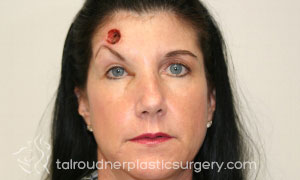Skin tumor treatment consists of tumor removal in most cases. A skin tumor is by definition an abnormal growth that can be either benign or malignant. For benign tumors often times an excisional biopsy is all that is needed, however for pre-malignant or malignant more extensive surgery and reconstruction maybe necessary.
According to the American Society of Plastic Surgeons, in their cosmetic national data bank statistic reports of 2010, tumor removal (including skin cancer)procedures were performed in 4,042,955 patients that year. That is a 2% increase from 2009.
Dr. Roudner’s goal is to remove any skin tumor in a safe and complete manner avoiding potential for recurrence, as well as facilitating reconstruction as needed with minimizing visible scaring.
In most cases Dr. Roudner performs an excisional biopsy of the tumor and may follow that biopsy with re-excision of the tissues for obtaining adequate margins . In cases were the tumor is located in aesthetically sensitive area and difficult area to reconstruct, either Mohs surgery or radiation therapy may be initiated first.
About Skin Cancer
Skin cancer is the most common cancer in humans. In the US more than 1 million people are diagnosed each year. The skin cancer cells grow and multiply in an abnormal fashion to form a mass called a tumor and are often referred to as lesions. The tumors are considered malignant (become progressively worse and to potentially result in death) when their uncontrolled growth invades neighboring tissues. The malignant cancer cell that invade local tissue may travel to remote areas in the body by the lymphatic or bloodstream in a process called metastasis. The overgrowth of the malignant cells overwhelm the normal surrounding tissues and depletes them from oxygen and nutrients causing cell death.
Types of Skin Cancers
There are three major types of skin cancer: Basal Cell Carcinoma (BCC), Squamous Cell Carcinoma (SCC) and melanoma. The majority of skin cancers are Basal Cell Carcinoma (BCC), Squamous Cell Carcinoma (SCC). Although these cancers are malignant, the potential for them to spread elsewhere in the body is small unless they are long standing and aggressive type. The maybe locally destructive and may cause disfigurement to local structures if not treated early in their natural progression. Melanoma is seen in a smaller but significant number of skin cancer patients and is a highly aggressive cancer that may be fatal if not treated in the early phase of the disease.
Development of Skin Cancer
Skin cancer develops from a dysplastic lesion (abnormality of development of the cells). Some of the precancerous lesions such as actinic keratosis which are re-brown rough scaly spots on the skin that may develop into SCC, dysplastic nevi (abnormal mole) may develop into melanoma.
Although moles (nevi) are common simple growths on the skin and rarely become cancer there are times were they may become suspicious and should be examined for the possibility of cancerous cells. Nevi that are irregular in shape, asymmetric, rough raised surface, larger the 6 mm with mixed colors (red, brown, black) and ulcerate or bleed are highly suspicious and should be biopsied to rule out a cancerous growth. When a person has more then 100 nevi the may have dysplastic nevi syndrome and have a higher likelihood of developing melanoma and should be followed regularly by a dermatologist. Children that are born with numerous nevi need to be followed closely and in some cases when the congenital nevi are very large may need to have surgery to remove them due to high potential to develop int a melanoma.
Skin cancer is most commonly caused by ultraviolet (UV) light exposure and most commonly from sunlight. Other sources of UV light are tanning booths. Other less common causes include X-ray radiation, arsenic, hydrocarbon and soot exposure. Immunosuppressed patients have a higher risk of developing cancer due to a reduced immune system that can fight the cancer cells. As well as patients that have had skin cancer in the past or have a close relative who had developed skin cancer.
People with fair skin, blond or red hair and light eyes have the highest risk of developing skin cancer. As well as people who suffer from conditions such as xeroderma pigmentosum and albinism due to lack of protecting pigmentation. Severe sun burn early in life increases the chance of skin cancer later in life.
Basal cell carcinoma and squamous cell carcinomas tend to occur later in life while melanomas are more common in younger people.
Basal cell carcinoma (BCC) is a raised, smooth, pearly appearing lesion that appears most commonly on sun-exposed skin of the head, neck, or shoulders. In the center of the lesion a central depression that usually crusts and bleeds and often is mistaken for a non-healing sore.
Squamous cell carcinoma (SCC) has a well-defined border with red, scaling, thickened skin on sun-exposed skin. It may ulcerate and bleed as well. It has a higher potential then BCC to spread if not treated in time.
Malignant melanomas are more common to appear as brown to black pigmented lesions. Suspicious lesions are pigmented lesions that are asymmetric have irregular borders and change in color (black,brown,blue,red, tan or white) are increasing in size (diameter greater the 6 mm) and elevation. Greater concern for potential malignancy are painful, itching, ulcerating or bleeding lesions.
The rate of skin cancer has been rising significantly in the past decade and the importance of proper sun protection and regular skin exams by health-care providers could not be overemphasized. With increase awareness both by the public and health care providers earlier diagnosis and improved outcomes are encouraging.












Request a Consultation
Call 305-767-7719 or Use the Form Below to Schedule Online!
Dr. Tal Roudner has either authored or reviewed and approved the content on this website.
Page Updated:


